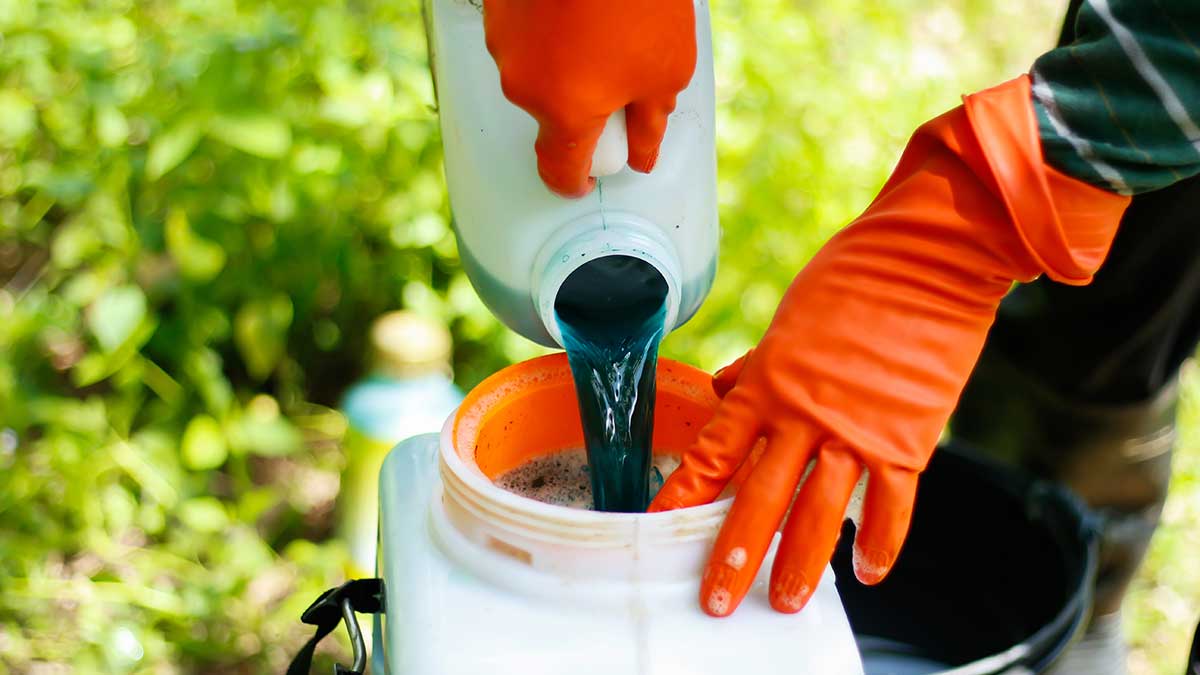Properly disposing of herbicide packaging, including any leftover product, is one of the easiest and most effective ways to minimize environmental harm. These chemicals can be hazardous if not handled correctly. Improper disposal can lead to contamination of soil, water, and wildlife.
Herbicides, especially those containing chemicals like glyphosates, can be harmful to the environment and human health. For example, a common ingredient in RoundUp and other weed killers, glyphosate, is linked to cancers, congenital disabilities, and neurodegenerative diseases; the loss of pollinators around the world is also attributed to this most-used herbicide. When herbicide products are disposed of incorrectly, they can leach into groundwater and streams, harming aquatic life and contributing to soil degradation.
Always follow local guidelines for disposal, checking Earth911 for local drop-off options or with manufacturers to discover whether they offer take-back programs.
10 Materials To Watch For
Here’s the list of herbicides, along with some familiar brand names under which they are sold:
- Glyphosate Brand Names: Roundup, Rodeo, Ranger Pro. These herbicides should be avoided for the health and environmental reasons described above.
- 2,4-D (2,4-Dichlorophenoxyacetic acid) Brand Names: Weedone, Amine 400, Barrage. 2,4-D is moderately toxic to humans, mammals, and birds but is highly toxic to fish. The U.S. Environmental Protection Agency says it does not harm bee populations.
- Atrazine Brand Names: AAtrex, Gesaprim, Triazine. Atrazine weedkillers are persistent, potentially harmful chemicals that are suspected, but not proven, to contribute to cancers and are known to damage the liver, kidney, and heart in animals.
- Paraquat Brand Names: Gramoxone, Para-Shot, Helmquat. Small doses of these herbicides are very toxic to humans and in the environment, causing heart, kidney, and liver failure, along with lung scarring.
- Dicamba Brand Names: Banvel, Clarity, Engenia. The EPA continues to study dicamba, a widely used non-specific agricultural herbicide applied to corn, cotton, asparagus, and golf course fairways. Dicamba has been linked to an elevated risk of liver cancers and chronic lymphocytic leukemia. When it escapes into the environment, these products kill plants that wildlife depend on for food.
- Triclopyr Brand Names: Garlon, Remedy, Crossbow. Although considered only slightly toxic to humans, it has been found to contribute to mammary tumors and adrenal gland conditions in rats. Triclopyr is non-specific, so it can kill any plant it contacts and is highly toxic to freshwater species — keep these out of your local water supply.
- Imazapyr Brand Names: Arsenal, Habitat, Chopper. Another non-specific herbicide that can wreak havoc on aquatic life when it reaches the water supply, imazapyr is only mildly toxic to mammals and birds, according to the EPA.
- Clopyralid Brand Names: Transline, Stinger, Reclaim. A relatively benign herbicide, clopyralid, is not considered acutely toxic to humans or other species. Still, it can attack plants that were not intended as targets.
- MCPA (Methylchlorophenoxyacetic acid) Brand Names: Agroxone, Chiptox, Rhonox. A selective herbicide that controls weeds, MCPA affects gene transcription in plants to prevent growth. It may be linked to some human cancers.
- Picloram Brand Names: Tordon, Grazon, Access. When picloram reaches the water supply, it is highly toxic to aquatic life and, because it persists in the environment, represents a long-term source of damage. Its long-term impact on human health has not been studied, but it causes a range of irritations when inhaled, ingested, or comes in contact with skin.
Step 1: Use What You Buy
If you must use a herbicide, the first and most straightforward way to reduce environmental contamination is to carefully calculate the amount of herbicide or fertilizer you need before purchasing. Use less to reduce the chances of having leftover products that require disposal. If you have leftovers, consider sharing them with neighbors or local gardening clubs who might need them instead of letting them go to waste.
Step 2: Read the Label
Before disposing of any herbicide or fertilizer, always read the label for specific disposal instructions. Manufacturers often provide guidelines on safely disposing of the product and its packaging. Following their disposal guidance is essential for products containing hazardous chemicals like glyphosate.
Step 3: Prepare the Packaging for Disposal
Packaging from herbicides and fertilizers should be rinsed thoroughly before disposal. Here’s how to do it safely:
- Triple-rinse containers, filling them with water, shaking them for about a half minute, and then emptying the rinse water back into your sprayer or onto the area you are treating. Rinse three times to remove all residues and reduce the risk of contamination.
- Never Pour Down the Drain. Do not dispose of herbicides, fertilizers, or hazardous chemicals down the drain or toilet or place leftover herbicides in the trash.
- Puncture Containers after rinsing to prevent reuse.
- Recycle or Dispose: Check if your local recycling facility accepts clean, empty plastic containers. Some communities have specific recycling programs for agricultural or hazardous waste. If recycling is not an option, follow the instructions on the label for disposal, usually involving placing the container in the trash.
Currently, no extended producer responsibility programs require manufacturers to fund the collection and handling of their herbicides or packaging. Check the product’s website or contact the manufacturer to see if they offer a takeback program. However, we cannot find any of them as of this writing. Alternatively, local agricultural extension offices might know of community disposal programs.
For most of the country, household hazardous waste (HHW) collection locations or events where you can drop off unused or leftover chemicals are the most convenient option. These programs ensure that hazardous materials are disposed of safely and not sent to landfills, where they can escape into the water supply. Visit Earth911 and add your ZIP Code to this search to find recycling and disposal options for hazardous materials near you. Another option is the Ag Container Recycling Council (ACRC). This non-profit organization provides recycling programs for agricultural chemical containers. Farmers can find herbicide collection sites and contractors on the ACRC website.
Handling Glyphosates Specifically
Glyphosate products require special attention due to their widespread use and potential risks. To manage glyphosate-containing products responsibly, try:
- Storing Safely: Keep glyphosate products in their original containers, tightly sealed, and stored in a cool, dry place away from children and pets.
- Following Label Instructions: Always follow the specific disposal instructions on the product label. Some glyphosate products may have particular requirements for rinsing and disposal.
- Seeking Out Recycling Options: In some areas, containers that hold glyphosate can be recycled through agricultural container recycling programs. Visit the Ag Container Recycling Council (ACRC) for more information.
- Utilizing HHW Programs: If you have leftover glyphosate you cannot use, your local HHW program is the safest way to dispose of it.
Widespread Challenge, Individual Action
Reducing herbicide use is the most powerful choice, but when you feel you must use these toxic chemicals, proper disposal of herbicide packaging and leftovers is not just about following the law. We must protect our environment and public health. By following the steps here, you can help ensure that these chemicals do not harm our planet. Eventually, we can restore nature to good health while feeding people or keeping the yard looking beautiful.

